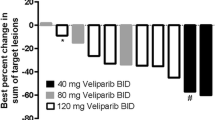Summary
Background: We tested the hypothesis that 3-aminopyridine-2-carboxaldehyde thiosemicarbazone (3-AP, Triapine®) may enhance response to re-treatment with gemcitabine by enhancing intracellular uptake of gemcitabine in a phase II study. Method: Patients who had prior exposure to gemcitabine as a first-line treatment of advanced non-small-cell lung cancer (NSCLC) were given weekly infusions of 3-AP and gemcitabine for 3 weeks followed by 1 week of rest, repeated every 28 days. Plasma and peripheral blood mononuclear cells (PBMCs) were collected to evaluate the effect of 3-AP on pharmacokinetics and intracellular uptake of gemcitabine. Result: Twelve patients were treated with a median of two treatment cycles without objective response, hence the study was terminated at interim analysis. Four patients had stable disease and the median time to progression was 3 months (95% confidence interval, CI: 1.7 to 9.1 months). Grade 3 toxicities included neutropenia (two patients), hypoxia (three patients) and dyspnea (one patient). Four patients developed reversible symptomatic methemoglobinemia during 3-AP infusion, with mild to moderately elevated methemoglobin levels that ranged from 7.8 to 17.6% of the total hemoglobin concentration. Limited pharmacokinetic data did not suggest any clinically relevant pharmacological influence of 3-AP on gemcitabine. Conclusion: 3-AP did not enhance clinical response to gemcitabine in this cohort of patients with prior exposure to gemcitabine for advanced NSCLC. Further development of 3-AP in lung cancer is challenged by its potential of causing methemoglobinemia and hypoxia, which could be problematic in patients with compromised pulmonary reserves.

Similar content being viewed by others
References
Finch RA, Liu M, Grill SP, Rose WC, Loomis R, Vasquez KM, Cheng Y, Sartorelli AC (2000) Triapine (3-aminopyridine-2-carboxaldehyde-thiosemicarbazone): a potent inhibitor of ribonucleotide reductase activity with broad spectrum antitumor activity. Biochem Pharmacol 59:983–991
Yu Y, Wong J, Lovejoy DB, Kalinowski DS, Richardson DR (2006) Chelators at the cancer coalface: desferrioxamine to Triapine and beyond. Clin Cancer Res 12:6876–6883
Chen C, King I, Belcourt M (2002) Triapine, a ribonucleotide reductase inhibitor, enhances incorporation of gemcitabine into DNA and cytotoxicity to KB cells. Proc AACR-EORTC conference 38: S26. Abstract 71
Yen Y, Margolin K, Doroshow J, Fishman M, Johnson B, Clairmont C, Sullivan D, Sznol M (2004) A phase I trial of 3-aminopyridine-2-carboxaldehyde thiosemicarbazone in combination with gemcitabine for patients with advanced cancer. Cancer Chemother Pharmacol 54:331–342
Foltz LM, Dalal BI, Wadsworth LD, Broady R, Chi K, Eisenhauer E, Kobayashi K, Kollmannsburger C (2006) Recognition and management of methemoglobinemia and hemolysis in a G6PD-deficient patient on experimental anticancer drug Triapine. Am J Hematol 81:210–211
Therasse P, Arbuck S, Eisenhauer E, Wanders J, Kaplan R, Rubinstein L, Verweij J, Van Glabbeke M, van Oosterom A, Christian M, Gwyther S (2000) New guidelines to evaluate the response to treatment in solid tumors. J Nat Cancer Instit 92:205–216
Wright R, Lewander W, Woolf AD (1999) Methemoglobinemia: etiology, pharmacology, and clinical management. Annals Emer Med 34:646–656
Wang LZ, Goh BC, Lee HS, Noordhuis P, Peters GJ (2003) An expedient assay for determination of gemcitabine and its metabolite in human plasma using isocratic ion-pair reversed-phase high-performance liquid chromatography. Ther Drug Monit 25:552–557
Soo RA, Wang LZ, Tham LS, Yong WP, Boyer M, Lim HL, Lee HS, Millward M, Liang S, Beale P, Lee SC, Goh BC (2006) A multicentre randomised phase II study of carboplatin in combination with gemcitabine at standard rate or fixed dose rate infusion in patients with advanced stage non-small-cell lung cancer. Ann Oncol 17:1128–1133
Fleming TR (1982) One-sample multiple testing procedure for phase II clinical trials. Biometrics 38:143–151
Crino L, Mosconi AM, Scagliotti G, Selvaggi G, Novello S, Rinaldi M, Della Giulia M, Gridelli C, Rossi A, Calandri C, De Marinis F, Noseda M, Tonato M (1999) Gemcitabine as second-line treatment for advanced non-small-cell lung cancer: a phase II trial. J Clin Oncol 17:2081–2085
Gridelli C, Perrone F, Gallo C, Rossi A, Barletta E, Barzelloni ML, Creazzola S, Gatani T, Fiore F, Guida C, Scognamiglio F (1999) Single-agent gemcitabine as second-line treatment in patients with advanced non small cell lung cancer (NSCLC): a phase II trial. Anticancer Res 19:4535–4538
Georgoulias V, Kourousis C, Kakolyris S, Androulakis N, Dimopoulos MA, Papadakis E, Kotsakis T, Vardakis N, Kalbakis K, Merambeliotakis N, Hatzidaki D (1997) Second-line treatment of advanced non-small cell lung cancer with paclitaxel and gemcitabine: a preliminary report on an active regimen. Semin Oncol 24:S12–61
Glaser R, Zhang HY, Yao KT, Zhu HC, Wang FX, Li GY, Wen DS, Li YP (1989) Two epithelial tumor cell lines (HNE-1 and HONE-1) latently infected with Epstein–Barr virus that were derived from nasopharyngeal carcinomas. Proc Natl Acad Sci USA 86:9524–9528
Knox JJ, Hotte SJ, Kollmannsberger C, Winquist E, Fisher B, Eisenhauer EA (2007) Phase II study of Triapine(R) in patients with metastatic renal cell carcinoma: a trial of the National Cancer Institute of Canada Clinical Trials Group (NCIC IND.161). Invest New Drugs 25:471–477
Hadjiliadis D, Govert JA (2000) Methemoglobinemia after nfusion of ifosfamide chemotherapy: first report of a potentially serious adverse reaction related to ifosfamide. Chest 118:1208–1210
Acknowledgement
This study was sponsored by the National Cancer Institute, Bethesda, USA (NCI protocol #6256).
Author information
Authors and Affiliations
Corresponding author
Rights and permissions
About this article
Cite this article
Ma, B., Goh, B.C., Tan, E.H. et al. A multicenter phase II trial of 3-aminopyridine-2-carboxaldehyde thiosemicarbazone (3-AP, Triapine®) and gemcitabine in advanced non-small-cell lung cancer with pharmacokinetic evaluation using peripheral blood mononuclear cells. Invest New Drugs 26, 169–173 (2008). https://doi.org/10.1007/s10637-007-9085-0
Received:
Accepted:
Published:
Issue Date:
DOI: https://doi.org/10.1007/s10637-007-9085-0




